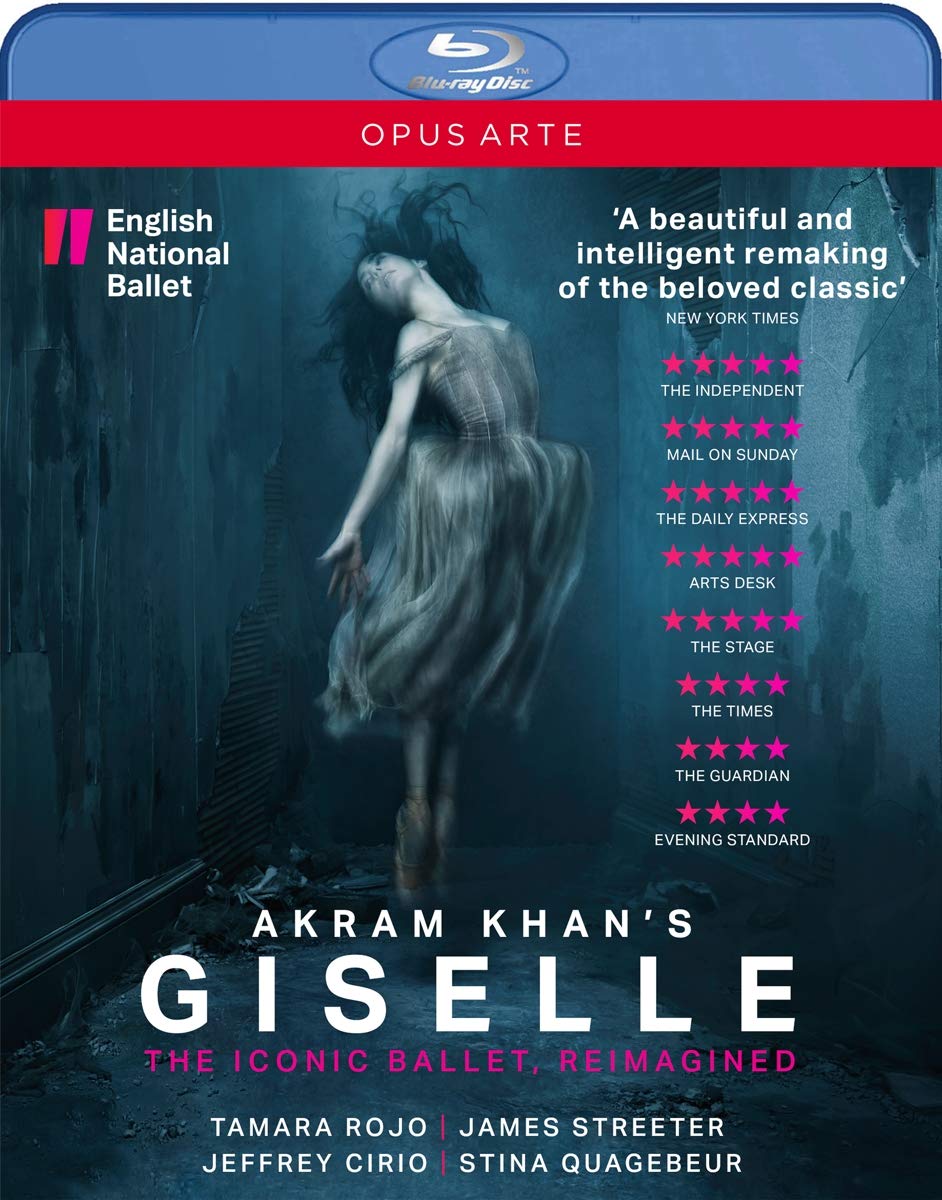

Giselle ballet. Modern musical composition and sound design by Vincenzo Lamagna after themes from Adolphe Adam. Directed and choreographed by Akram Khan. Performed 2017 at the Liverpool Empire Theatre. Stars are Tamara Rojo (Giselle); James Streeter (Albrecht); Jeffrey Cirio (Hilarion); Stina Quagebeur (Myrtha, Queen of the Wilis); Begoña Cao (Bathilde); Fabian Reimair (Landlord); as well as Jung ah Choi, Anjuli Hudson, Maria José Sales, and Adela Ramírez (Giselle’s Friends). Ensemble dancers playing Outcasts: Precious Adams, Aitor Arrieta, William Beagley, Francisco Bosch, Georgia Bould, Barry Drummond, Shevelle Dynott, Giorgio Garrett, Jennie Harrington, Amber Hunt, Rina Kanehara, Daniel Kraus, Sarah Kundi, Van Le Ngoc, Laurent Liotardo, Adriana Lizardi, Guilherme Menezes, Ken Saruhashi, Emily Suzuki, Francesca Velicu, Vonnie Vowles, Angela Wood, Erik Woolhouse, and Jia Zhang. Ensemble dancers playing Court Couples: Matthew Astley, Claire Bennett, Julia Conway, and William Simmons. Ensemble dancers playing Wilis: Precious Adams, Jung ah Choi, Emilie Cadorin, Eireen Evrad, Jennie Harrington, Tiffany Hedman, Anjuli Hudson, Amber Hunt, Maria José Sales, Rina Kanehara, Sarah Kundi, Adriana Lizardi, Alison McWhinney, Francesca Velicu, Connie Vowles, and Angela Wood. Gavin Sutherland directs the English National Ballet Philharmonic (Leader Matthew Scrivener). Visual and costume design by Tim Yip; orchestration by Gavin Sutherland; lighting design by Mark Henderson; dramaturgy by Ruth Little; assistant choreography by Andrej Petrović; rehearsal direction by Mavin Khoo; sound design by Yvonne Gilbert. Directed for TV by Ross MacGibbon; produced by Janie Valentine and Nikki Weston. Released 2019, disc has 5.1 dts-HD Master Audio sound. Grade: A-
Akram Khan’s Giselle has been out about 4 years now (January 2020) and is probably the most significant new dance piece of recent years. It’s been selling out in England regularly and has appeared in other countries live and in movie houses.
Look at our list of best modern dance pieces published in Blu-ray, and you see that Khan’s Giselle is easily the most distinctive and challenging contemporary work to make it into the home theater. And it’s also relatively easy to digest and comprehend since the simple plot is the same as the classic Giselle long beloved by most ballet fans.
Many print critics have gone into convulsions complaining how Khan’s version is different from what you might see at the Paris Garnier in the Petipa tradition. Of course it’s different. The story has been moved 500 years from the middle ages to post-modern times following the inundation of most of the world’s coastal regions and maybe World War III as well. The old class concepts of Marxian doctrine have been replaced by 2 new classes: those who lived on the high ground and those who were flooded out. (The synopsis in the keepcase booklet speaks of migrant factory workers of today, but I’ll stick to my climate catastrophe scenario.)
Below are the outcasts standing between a sea barrier and the rising waters. In the center is Albrecht (James Streeter), son of the grand Landlord, telling the outcasts that they must move elsewhere. On Albrecht’s right is the proud Hilarion (Jeffrey Cirio), a kind of Kapo, and on his left stands Giselle (Tamara Rojo). Both men are in love with Giselle, who is secretly carrying Albrecht’s child:
The Outcasts migrate as instructed. The landlord (Fabian Reimar) and his entourage cross the sea barrier (constructed world wide) to visit the Outcasts. To his right is his daughter Bathilde (Becoña Cao) in the black skirt:
Giselle admires Bathilde's skirt as it was made in the factory where Giselle used to work:
The Outcasts entertain the Landlords. You can see handprints of the Outcasts on the wall:
Giselle is shocked to learn of Albrecht’s relationship with Bathilde:
Giselle frantically reminds Albrecht of her pregnancy:
The death of Giselle:
Hilarion mourns Giselle:
Myrtha (Stina Quagebeur), Queen of the Wilis, welcomes Giselle:
The Wilis:
Death of Hilarion:
Giselle defies Myrtha:
Giselle forgives Albrecht:
The most significant difference between Khan’s Giselle and the traditional story is Giselle’s pregnancy. I kept wondering if the expected child would somehow result in a reprieve for Giselle. But no, it only increases the tragedy for Albrecht:
At the end, Albrecht is left all alone:
Now you can see that Khan’s story line is almost identical to the classical Giselle. The differences are in the era, the mise-en-scène, and, of course, the music. A few of the familiar melodies from Adam’s music creep into Lamagna’s score, but the music is mostly electronically produced in today’s style of post-modern movie music generally. I’ve heard so much of this now that I actually enjoy it. It’s completely appropriate for the style of dancing and imagery being offered. There is also some fine acting, especially by RoJo and Cirio as Hilarion. So you get a sad story about a pregnant girl who died and some other things to think about.
I started on a Work Worksheet. After 3 chapters I stopped and figured that the pace was 7.7 sec. per clip and the full body shots were about 54% of the record. This was unfortunate. It seems to me with this simple story, bare set, repetitive dance steps, and only 4 cameramen, it would have been so easy to make a record with chips of 30 secs each or longer for the entire show. Why work so hard to make a DVD when it would have been so easy to make something neat for HD display? I know, it’s harder than one thinks. Grade: A-.
Here are two clips from the English National Ballet:
And here is a trailer from the English National Ballet:
OR
















